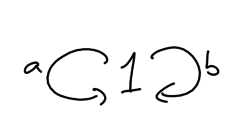Difference between revisions of "M(8,2,1)"
(→Projective indecomposable modules) |
|||
| Line 24: | Line 24: | ||
|O-morita-frob = 1 | |O-morita-frob = 1 | ||
|Pic-O = <math>(C_4 \times C_2):(C_2 \times C_2 \times C_2)</math> | |Pic-O = <math>(C_4 \times C_2):(C_2 \times C_2 \times C_2)</math> | ||
| + | |PIgroup = | ||
|source? = | |source? = | ||
|sourcereps = | |sourcereps = | ||
| Line 29: | Line 30: | ||
|k-derived = Forms a derived equivalence class | |k-derived = Forms a derived equivalence class | ||
|O-derived-known? = Yes | |O-derived-known? = Yes | ||
| + | |coveringblocks = M(8,2,1) | ||
| + | |coveredblocks = M(8,2,1) | ||
| + | |pcoveringblocks = [[M(16,2,1)]], [[M(16,3,1)]], [[M(16,4,1)]], | ||
| + | [[M(16,5,1)]], [[M(16,6,1)]], [[M(16,10,1)]], | ||
| + | [[M(16,11,1)]], [[M(16,12,1)]], [[M(16,13,1)]] | ||
}} | }} | ||
| Line 41: | Line 47: | ||
== Other notatable representatives == | == Other notatable representatives == | ||
| − | |||
| − | |||
| − | |||
| − | |||
| − | |||
| − | |||
== Projective indecomposable modules == | == Projective indecomposable modules == | ||
Latest revision as of 12:33, 1 November 2018
M(8,2,1) - [math]k(C_4 \times C_2)[/math]
| Representative: | [math]k(C_4 \times C_2)[/math] |
|---|---|
| Defect groups: | [math]C_4 \times C_2[/math] |
| Inertial quotients: | [math]1[/math] |
| [math]k(B)=[/math] | 8 |
| [math]l(B)=[/math] | 1 |
| [math]{\rm mf}_k(B)=[/math] | 1 |
| [math]{\rm Pic}_k(B)=[/math] | |
| Cartan matrix: | [math]\left( \begin{array}{c} 8 \\ \end{array} \right)[/math] |
| Defect group Morita invariant? | Yes |
| Inertial quotient Morita invariant? | Yes |
| [math]\mathcal{O}[/math]-Morita classes known? | Yes |
| [math]\mathcal{O}[/math]-Morita classes: | [math]\mathcal{O} (C_4 \times C_2)[/math] |
| Decomposition matrices: | [math]\left( \begin{array}{c} 1 \\ 1 \\ \vdots \\ 1 \\ \end{array}\right)[/math] |
| [math]{\rm mf}_\mathcal{O}(B)=[/math] | 1 |
| [math]{\rm Pic}_{\mathcal{O}}(B)=[/math] | [math](C_4 \times C_2):(C_2 \times C_2 \times C_2)[/math] |
| [math]PI(B)=[/math] | |
| Source algebras known? | |
| Source algebra reps: | |
| [math]k[/math]-derived equiv. classes known? | Yes |
| [math]k[/math]-derived equivalent to: | Forms a derived equivalence class |
| [math]\mathcal{O}[/math]-derived equiv. classes known? | Yes |
| [math]p'[/math]-index covering blocks: | M(8,2,1) |
| [math]p'[/math]-index covered blocks: | M(8,2,1) |
| Index [math]p[/math] covering blocks: | M(16,2,1), M(16,3,1), M(16,4,1),
M(16,5,1), M(16,6,1), M(16,10,1), M(16,11,1), M(16,12,1), M(16,13,1) |
These are nilpotent blocks.
Contents
Basic algebra
Quiver: a:<1,1>, b:<1,1>
Relations w.r.t. [math]k[/math]: a^4=b^2=ab+ba=0
Other notatable representatives
Projective indecomposable modules
Labelling the unique simple [math]B[/math]-module by [math]1[/math], the unique projective indecomposable module has Loewy structure as follows:
[math]\begin{array}{c} 1 \\ 1 \ 1 \\ 1 \ 1 \\ 1 \ 1 \\ 1 \\ \end{array} [/math]
Irreducible characters
All irreducible characters have height zero.
